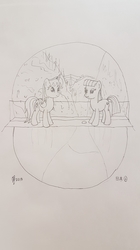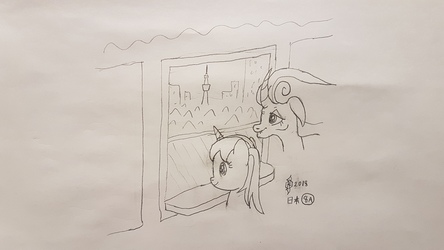Sign In
CloseParcly Taxel: The restaurant near Niigata Station I noted down the day before is Uonuma Kamakura (魚沼釜蔵), accessible from the Ponshukan (ぽんしゅ館) sake shop. Their breakfast service is a buffet with both Japanese and Western foods; the former include cold soba and curry rice, the latter include scrambled eggs and toast. Curry rice was in fact imported from the British, but the local variety has evolved so much as to be indistinguishable from the original.
Rainbow Dash: It was cloudy above as she made her way there. Japan's weather is heavily influenced by its mountains, which corral or spread wind currents around like balls in a pachinko machine – it can be snowing one moment and sunny the next or vice versa. Since the status of certain attractions and events can depend on weather, and also because of the possibility of extraordinary phenomena like typhoons, forecasts are more detailed than in other lands, with resolutions of less than a day (typically three or six or twelve hours).
Then she stepped into rain walking out of the Dormy Inn.
Spindle: Splashed on the morning news briefs displayed just outside the station gates were accounts of a gas explosion and subsequent roof collapse in Sapporo that had occurred mere hours before, injuring 42. The ideographic nature of the Japanese language, including kanji, allows very high levels of data compression: complete Tokyo Stock Exchange activity can fit in two newspaper pages and five reports can easily run on one page.
Parcly: I still had those "onsen lips" retaining traces of the onsen water from last night, milky to the tongue, though eating food had dampened that flavour somewhat. The Senbei Ōkoku (せんべい王国) rice cracker museum in Niigata's outskirts followed. In the typical style of a food museum, there were models/videos of the production process, nutritional and other facts on the glutinous rice that goes into the crackers and hooves-on stations.
Spindle: While that was a short excursion, our next stop was all the way down in the twin cities of Tsubame and Sanjō (燕三条). The distant mountains bore a different kind of serenity, their bases covered by low-lying clouds that gave the impression of a floating paradise.
Tsubame, the "Artisan Village", is a centre for small-scale metalworking, crafting cutlery and tools made out of steel, bronze or similar materials. A "regional industries promotion centre" aggregated the outputs of many artisan families for sale, so we checked it out. Fascinating items like titanium cups and gold-plated sake cups were on offer, as well as more mundane but still wacky instruments like flower cutters and scoops for the rice in sushi. When we came there was also a craftspony, who appeared only on scheduled days, demonstrating the metalworking process.
Parcly: I wandered around the area, stumbling across a poster for a mountain cable car 634 m high, the Tokyo Skytree's height. Was it interesting? Not very much, as a quick head turn revealed Yahiko Shrine (彌彦神社), ancient among ancients. I presumed Luna manipulated my subconscious to pull me there, receiving confirmation shortly afterwards. "Enjoy!" was the last sentence she switched into my head then.
Princess Luna: That even a poem 1200 years back called that shrine "ancient" testifies to its prehistoricity, although the current buildings are only around 100 years old, having been rebuilt after a fire. Revered inside is Ame-no-Kaguyama-no-Mikoto (天香山命), a kami said to have taught the inhabitants of Echigo, the old province corresponding to Niigata Prefecture, fishing and farming. As it turns out, the nearby mountain of the same name (弥彦山) is the shrine's shintai (神体) or "home" of the kami.
Parcly: The sky's floodgates opened just as I finished my visit, forcing me to run back to the city under a magic bubble, but not without visiting many of the standalone department stores along the way. Back at the Ponshukan in Niigata Station I had another look at the sake. That the establishment was open was signalled by a statue of a pony holding up a bottle of the stuff – I had seen it being rolled out at breakfast.
Over a hundred different Niigata breweries were represented at the sake tasting gallery. Most of them had their flavour characteristics listed, including acidity, dryness (higher is dry, lower is sweet), grain used, amount of washing, whether it was "suitable for mares" and alcohol proof. The last factor is what really puts me off alcohol in general, since most drinks are just too strong for my liking. Indeed, the alcohol levels by volume in a related drink, the Chinese maotai (茅台), used to be around 65%, on the order of the ethanol disinfectants I used in my old biology classes.
Spindle: We were tempted to have Uonuma Kamakura for dinner, but I found all the seats taken and full of friendship, as it is near Hearth's Warming. Parcly had a wagyu beef Mos Burger instead.
For the last time, she bathed in the Dormy Inn's Taho no Yu (多宝の湯) onsen and ate the free ramen. While she was trading sore muscles for heat, I packed up the luggage in preparation for checking out tomorrow, whereupon we would take the Shinkansen back to the great wen of Tokyo.
Submission Information
- Views:
- 442
- Comments:
- 0
- Favorites:
- 1
- Rating:
- General
- Category:
- Visual / Traditional




